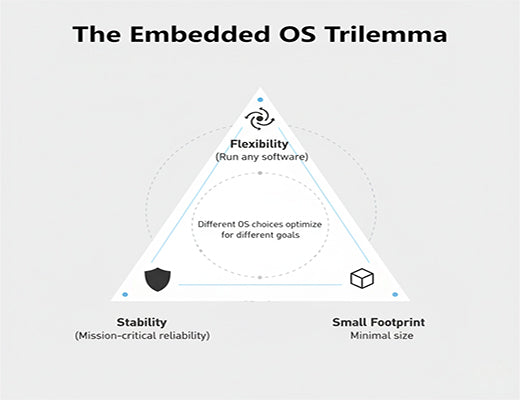
Choosing an OS for the Edge: The Case for a Debian-Based Platform with Long-Term Support (LTS)
|
|
Time to read 6 min
|
|
Time to read 6 min
When choosing an OS for the edge, the decision has long-term strategic consequences. This guide makes the case for why a stable, open, Debian-based system with Long-Term Support (LTS) offers significant advantages over proprietary systems or highly customized builds like Yocto. For most industrial IoT projects, a Debian for IoT approach provides an unparalleled combination of developer flexibility, access to a massive software ecosystem, and a clear, reliable path for long-term security updates, making it the ideal choice for professional, scalable deployments.
The choice of an edge operating system is a critical architectural decision that impacts your entire project's lifecycle, from development speed to long-term security.
A Debian-based OS provides a familiar environment for developers and instant access to over 50,000 pre-compiled software packages via the apt package manager, dramatically accelerating development.
Long-Term Support (LTS) is a non-negotiable requirement for industrial products, guaranteeing you will receive critical security updates for the device's 5-10 year operational lifespan.
An open, Debian-based platform like Robustel's RobustOS Pro reduces vendor lock-in and allows you to easily migrate applications developed on a Raspberry Pi to production-grade hardware.
I've had this conversation many times with engineering leaders. They're selecting an edge gateway for a new IoT project. They spend weeks scrutinizing the hardware specs—CPU speed, memory, I/O ports. But they often spend only minutes thinking about the most important component of all: the operating system.
Let's be clear: choosing the hardware for your edge gateway is like picking the model of your car. choosing an OS for the edge is like picking the engine, the transmission, and the entire road network it's allowed to drive on. It's the fundamental architectural decision that dictates everything you can do with your hardware investment.
This guide will break down the common choices and make the case for why a mature, open, Debian-based platform is the smartest strategic choice for the vast majority of industrial projects.

For most professional IIoT projects, a Debian-based system offers a strategic advantage that is almost impossible to ignore.
apt-get install .... You have instant access to a stable, secure repository of over 50,000 pre-compiled software packages. This can save your development team hundreds, if not thousands, of hours compared to building everything from source in Yocto.Learn more about our Debian-based OS: [What is RobustOS Pro? A Guide to a Debian-Based OS for Industry]

Now for the most critical feature of all—one that is often buried in the fine print. Industrial products are not like consumer phones; they are expected to operate in the field for 5, 7, or even 10+ years.
What happens in year three when a critical security vulnerability (like Log4j) is discovered in a core Linux library?
Let's be blunt: deploying an industrial product without a clear LTS strategy is professional negligence.

When choosing an OS for the edge, you are making a decision that will impact your project for the next decade. While highly customized systems have their place, for the vast majority of industrial edge applications, a Debian-based OS with a clear Long-Term Support (LTS) strategy provides the best possible balance. It empowers your developers with maximum flexibility and speed today, while giving you the peace of mind that your deployment will remain secure and supportable for its entire operational life.
Learn more in our main guide:
A1: Yes, when it is properly "hardened" and maintained by the hardware vendor. A vendor's industrial OS (like Robustel's RobustOS Pro) takes the stable Debian core and adds industrial-specific security features, removes non-essential services, and, most importantly, is developed under a secure lifecycle process (like IEC 62443-4-1) to ensure its integrity.
A2: This was a concern a decade ago, but with modern industrial gateways that use reliable, high-capacity eMMC storage (8GB, 16GB, or more), the OS size is no longer a significant constraint. The immense benefits of having a massive, stable software ecosystem on the device far outweigh the marginal increase in storage footprint.
A3: The Yocto Project is not a Linux distribution itself, but rather a "factory" that gives you the tools to build your own, completely custom Linux distribution from source code. It's extremely powerful for creating a minimal, purpose-built OS, but it is also significantly more complex to learn and maintain than using a pre-existing distribution like Debian.